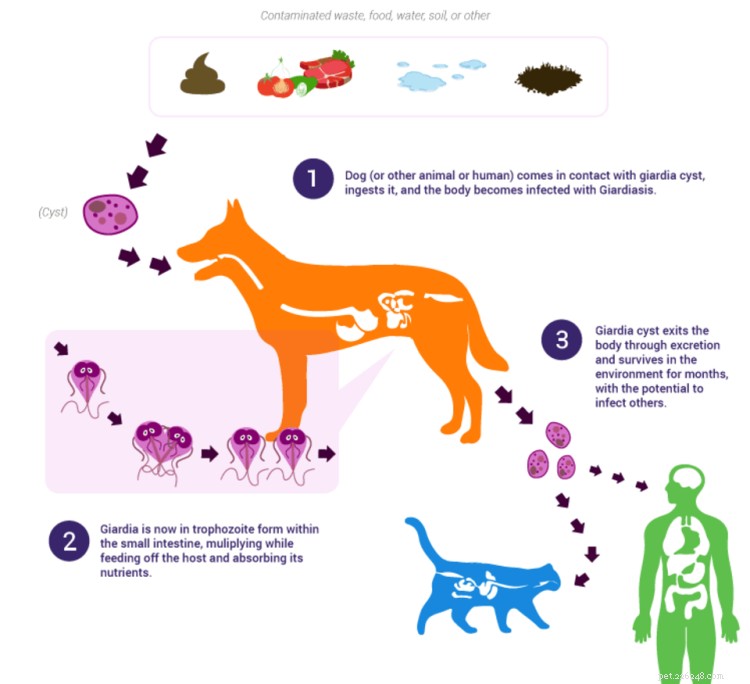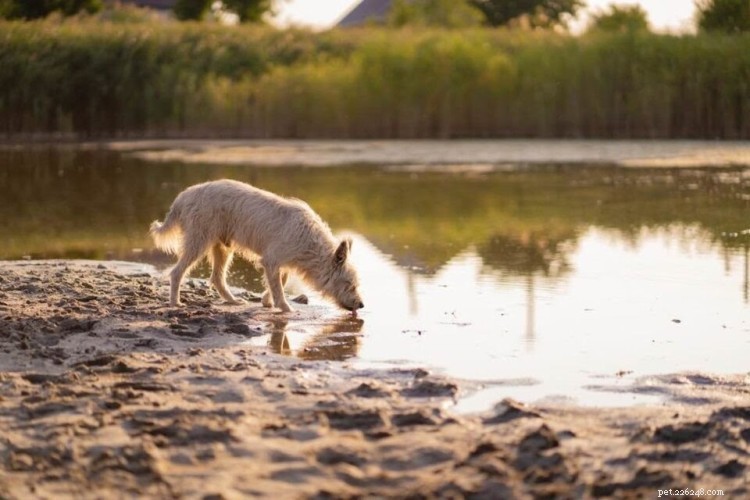Giardia em cães:causas, sintomas e tratamento
Giardia é um parasita comum que é facilmente transmissível entre cães, gatos e humanos. Causa diarreia e vômitos, entre outros sintomas, mas, felizmente, existem algumas medidas que os pais podem tomar para proteger seus filhotes da infecção.
Aqui está tudo o que você precisa saber sobre as causas, sintomas e tratamento da giardíase em cães para ajudar a manter seu ente querido seguro.
Dica profissional :Algumas apólices de seguro de animais de estimação cobrem condições como Giardia, tosse do canil e parvo, desde que a condição não seja pré-existente, todas as vacinas exigidas ou recomendadas estejam atualizadas e medidas preventivas tenham sido tomadas.
Índice:
- O que é Giardia?
- Como a Giardia se espalha?
- Quem está em risco de Giardia?
- A Giardia é perigosa em cães?
- Sintomas de Giardia em cães
- Como a Giardia é diagnosticada em cães?
- Tratando Giardia em cães
- Como limpar a casa se seu cão tem Giardia
- Prevenção da Giardia em cães
- Principais conclusões
O que é Giardia?
Giardia, também chamada de Giardia duodenalis ou Giardia intestinalis em termos veterinários, é um parasita unicelular que se multiplica nos intestinos de mamíferos, anfíbios e aves .
Existem diferentes formas do parasita Giardia - cistos e trofozoítos - mas ambos causam efeitos semelhantes em cães. Os trofozoítos são parasitas maduros que vivem no intestino delgado, onde eventualmente se tornam cistos, que são eliminados nas fezes do animal infectado. Os cistos podem sobreviver por semanas ou meses em diferentes ambientes, mesmo em condições úmidas ou frias.
Como a Giardia se espalha?
Os cães podem ser infectados com Giardia após a ingestão do parasita. Eles podem comer algo contaminado por fezes (grama, gravetos, etc.) ou beber água contaminada (poças). Os cães podem ser notoriamente bons em mastigar todos os tipos de objetos, então o risco de infecção por Giardia é bastante alto.
A infecção por Giardia em cães também pode ser transmitida por filhotes que brincam e rolam em solo contaminado, ou lambendo o corpo após o contato com uma superfície contaminada (caixa de cachorro, caixa de areia, etc.).
Uma vez que a Giardia entra no intestino do cão, o parasita pode se espalhar – mesmo que seu animal de estimação não apresente sintomas de infecção. Isso pode ser bastante problemático, especialmente para aqueles com vários animais de estimação em casa. As transmissões entre espécies são raras, mas o parasita é facilmente transmissível de um cão para outro. Portanto, se um de seus cães for diagnosticado com Giardia, consulte seu veterinário sobre as precauções que você deve tomar para proteger seus outros filhotes.
Quem está em risco de Giardia?
Todas as raças correm risco de Giardia, mas cães e filhotes mais velhos correm maior risco devido ao seu sistema imunológico fraco ou comprometido . A giardíase também é mais comum em animais confinados em grupos, como alojamentos ou canis.
Giardia é um parasita zoonótico, o que significa que pode ser transmitido para humanos, por isso você deve sempre ter cuidado ao manusear as fezes do seu filhote e lavar bem as mãos depois. Além disso, evite beber água de rios, córregos e riachos, purificando-a primeiro. O parasita pode estar presente no solo e nos alimentos, portanto, é aconselhável limpar todos os produtos antes de cozinhar.

A Giardia é perigosa em cães?
Animais de estimação com giardíase costumam responder bem ao tratamento e não sofrem consequências duradouras. No entanto, A giardíase é muito perigosa para animais com imunidade comprometida , incluindo cães mais jovens e mais velhos
Nem todos os cães apresentam sintomas de infecção por Giardia, mas pode ser muito desagradável para aqueles que o fazem. O parasita Giardia obstrui a capacidade dos cães de absorver adequadamente nutrientes, eletrólitos e água, resultando em diarreia . A diarreia pode ser leve ou explosiva, intermitente ou contínua, mas os filhotes geralmente são os piores.
Failure to diagnose dog Giardia can delay treatment, leading to sudden weight loss, dehydration, and the development of more serious health concerns - in severe cases, even death.
Symptoms of Giardia in dogs
Some dogs are asymptomatic, while others might present the following Giardia symptoms:
- Vômitos
- Náusea
- Diarréia
- Desidratação
- Perda de peso
- Diminuição do apetite
- Failure to gain weight
- Abdominal discomfort
- Gas or bloating
- Soft and pale stool with mucus
- Foul-smelling stool
- Steatorrhea (stool that has an oily or greasy appearance)
- Lack of energy
- Aparência ruim do casaco
If your beloved pet has a secondary infection or an immunosuppressive disease, the symptoms might be more intense. Be sure to talk to your veterinarian about an appropriate treatment plan O mais breve possível.
How is Giardia diagnosed in dogs?
The diagnosis of Giardia can be tricky because the cysts are shed in the feces intermittently. The standard diagnostic procedures, like complete blood count, urinalysis, and serum biochemistry will likely show normal results. Any abnormality present might result from lack of electrolytes due to dehydration caused by diarrhea - not the parasite directly. Your vet may therefore recommend additional tests to rule out possible conditions associated with your dog's symptoms.
The tests that give an accurate diagnosis of Giardia infection include:
- Direct fluorescent antibody assay (DFA) and fecal ELISA - Both can confirm the presence of Giardia, but testing needs to be done three times over five consecutive days to increase the chance of detection to 90%.
- Fecal flotation - A test used to detect cysts in the stool.
- Direct smear - Requires a fresh stool sample to detect first-stage trophozoites with a 70% chance of success.
Your vet might recommend a combination of tests before a final diagnosis is made.
Dica profissional: If you notice any symptoms, the value of pet insurance shines during diagnostic coverage. Many plans provide reimbursement for the cost of testing, which is the only way to determine whether your dog has a Giardia infection or a larger health concern. Don’t attempt to check for cysts in your dog’s feces; they’re invisible to the human eye.
 (Image source:Hospital Veterinari Glories)
(Image source:Hospital Veterinari Glories) Treating Giardia in dogs
Giardia infection is known to lead to digestive motility disorders and can induce inflammatory bowel disease, so all pets who contract the parasite should be treated by a vet .
Typically, the best treatment for Giardia is oral medicine, usually antiparasitic drugs and/or antibiotics that you can administer at home. The length of treatment depends on the drug chosen by the vet but typically lasts three to 10 days.
Your vet will also recommend bathing with a prescription shampoo on a regular basis to remove cysts and fecal matter from your dog’s fur and skin. Pay special attention to the hind legs, as this is where the cysts are most likely to be.
If your dog has severe dehydration caused by explosive diarrhea, they might be hospitalized to reduce the amount of stool movement before treatment starts. If your pet is vomiting persistently, stick to a bland diet once the vomiting is resolved.
With proper treatment, you can get rid of the parasite within two weeks. Be sure to follow your vet’s recommendations closely and take your dog to all follow-up appointments as requested.
How to clean the home if your dog has Giardia
All furniture, carpet, and toys that might have had contact with the infected animal must be cleaned to ensure there are no cysts lingering around the house.
First, scrub hard surfaces like floors, tables, crates, and trash cans with soap, then disinfect using bleach and water (3/4 cup of bleach per one gallon of water).
Clean upholstered furniture and carpet should be cleaned with regular detergent and disinfect by steam cleaning the area at 212°F for one minute (or 158°F for five minutes).
Other items like toys, pet beds, and clothing should be cleaned and sanitized on a daily basis the dog's treatment for Giardia infection. Dishwasher-safe food and water bowls can be cleaned in a dishwasher that has a dry cycle. If you don’t have a dishwasher, submerge these items in boiling water for at least one minute.
Clothing, bedding, and linens can be washed in the washing machine and then left to air dry thoroughly. If you have a clothes dryer, dry the clothes on the highest heat setting for half an hour.
If your pet is taking medication, wash linens frequently until a few days after the last dose of medication is given. Giardia’s survival depends on several factors, so it’s best to consult your vet for further advice.
Preventing Giardia in dogs
When it comes to Giardia prevention, a little effort can go a long way. Even though it’s not always possible to control every aspect of your pup’s environment, there are certain things you can do to prevent them from catching the disease.
The most important thing is to reduce the chances of your dog drinking from contaminated water by ensuring access to fresh and clean water at all times. Before you take your pup for a walk, make sure they’ve had plenty of water or consider bringing some along. If your water source is known to contain Giardia, consider boiling your pup’s water or buying a filter that’s proven to remove the parasitic cysts from the water.
Keep an eye on your furry pal while they’re out, making sure that they don’t eat anything off the ground. Avoid areas where there may be large amounts of dog feces in the environment and be careful to avoid leaving your pup at group facilities that do not thoroughly sanitize the grounds.
Finally, pay attention to general hygiene. Pick up after your pup whenever they go potty to practice good manners and prevent the spread of Giardia in environment.
All pups, even those without diarrhea and those on year-round parasite preventives, should have at least one or two fecal samples performed each year to screen for gastrointestinal parasites, including Giardia.
Final thoughts
If you’re concerned that your pup might have caught the parasite, get in touch with your veterinarian. They will help you determine if your pet needs to be examined and can provide more specific tips on how to prevent Giardia in your dog for future reference.
Principais conclusões
- Giardia is a parasite that attacks the intestines and causes diarrhea in humans and animals.
- Giardia spreads to dogs very easily through food, water, and soil contaminated by feces in the environment.
- A veterinarian may need to conduct tests to diagnose Giardia in dogs because the symptoms can be difficult to identify.
- Pet insurance can help cover the cost of testing and treatment, but be sure to thoroughly desanitize your home to reduce the risk of reinfection due to cysts living on contaminated surfaces.
- Alergias a cães:causas, sintomas e tratamento
- Cinomose em cães:causas, sintomas e tratamento
- Doença cardíaca em cães:sintomas, causas, tratamento
- Diabetes em cães:causas, sintomas e tratamento
- Olho de cereja em cães:causas, sintomas e tratamento
- Infecções de ouvido em cães:causas, sintomas e tratamento
- Insuficiência renal em cães:causas, sintomas e tratamento

